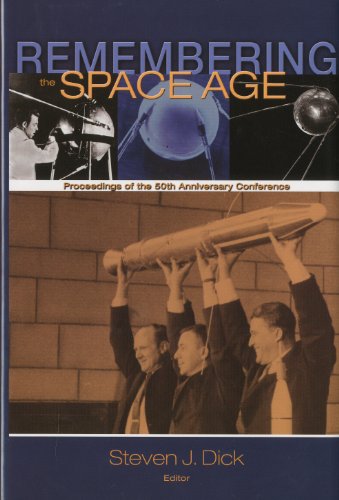Remembering the Space Age: Proceedings of the 50th Anniversary Conference: Proceedings on the 50th Anniversary Conference - Hardcover

Inhaltsangabe
Proceedings of October 2007 conference, sponsored by the NASA History Division and the National Air and Space Museum, to commemorate the 50th anniversary of the Sputnik 1 launch in October 1957 and the dawn of the space age.
Die Inhaltsangabe kann sich auf eine andere Ausgabe dieses Titels beziehen.
Reseña del editor
Proceedings of October 2007 conference, sponsored by the NASA History Division and the National Air and Space Museum, to commemorate the 50th anniversary of the Sputnik 1 launch in October 1957 and the dawn of the space age.
„Über diesen Titel“ kann sich auf eine andere Ausgabe dieses Titels beziehen.
Weitere beliebte Ausgaben desselben Titels
Suchergebnisse für Remembering the Space Age: Proceedings of the 50th...
Remembering the Space Age : Proceedings of the 50th Anniversary Conference
Anbieter: Better World Books, Mishawaka, IN, USA
Zustand: Very Good. First. Used book that is in excellent condition. May show signs of wear or have minor defects. Artikel-Nr. 4767928-6
Remembering the Space Age: Proceedings of the 50th Anniversary Conference: Proceedings on the 50th Anniversary Conference
Anbieter: Wonder Book, Frederick, MD, USA
Zustand: As New. Like New condition. Like New dust jacket. A near perfect copy that may have very minor cosmetic defects. Artikel-Nr. U05K-00261
Remembering the Space Age: Proceedings of the 50th Anniversary Conference: Proceedings on the 50th Anniversary Conference
Anbieter: Wonder Book, Frederick, MD, USA
Zustand: Very Good. Very Good condition. Very Good dust jacket. A copy that may have a few cosmetic defects. May also contain light spine creasing or a few markings such as an owner's name, short gifter's inscription or light stamp. Artikel-Nr. F10A-01695
Remembering the Space Age: Proceedings of the 50th Anniversary Conference: Proceedings on the 50th Anniversary Conference
Anbieter: ThriftBooks-Dallas, Dallas, TX, USA
Hardcover. Zustand: Very Good. No Jacket. Missing dust jacket; May have limited writing in cover pages. Pages are unmarked. ~ ThriftBooks: Read More, Spend Less. Artikel-Nr. G0160817234I4N01
Remembering the Space Age: Proceedings of the 50th Anniversary Conference: Proceedings on the 50th Anniversary Conference
Anbieter: Books From California, Simi Valley, CA, USA
Hardcover. Zustand: Very Good. Artikel-Nr. mon0002868372
Remembering the Space Age; NASA SP-2008-4703
Anbieter: Ground Zero Books, Ltd., Silver Spring, MD, USA
ardcover. Zustand: Very good. Zustand des Schutzumschlags: Very good. Presumed First Edition, First printing. xiii, [1], 465, [1] pages. Illustrations (some in color). About the Authors. Acronyms and Abbreviations. NASA History Series. Index. Proceedings of October 2007 conference, sponsored by the NASA History Division and the National Air and Space Museum, to commemorate the 50th anniversary of the Sputnik 1 launch in October 1957 and the dawn of the space age. Among the authors are: Roger D. Launius, John M. Logsdon, and Hans Mark. Steven J. Dick (born October 24, 1949, Evansville, Indiana) is an American astronomer, author, and historian of science most noted for his work in the field of astrobiology. Dick served as the Chief Historian for the National Aeronautics and Space Administration from 2003 to 2009 and as the Baruch S. Blumberg NASA/Library of Congress Chair in Astrobiology from 2013 to 2014. Before that, he was an astronomer and historian of science at the United States Naval Observatory in Washington, DC, from 1979 to 2003. Fifty years ago, with the launch of Sputnik I on October 4, 1957 and the flurry of activity that followed, events were building toward what some historians now recognize as a watershed in historyâ"the beginning of the Space Age. There is no doubt that the last 50 years have witnessed numerous accomplishments in what has often been termed "the new ocean" of space, harking back to a long tradition of exploration. Earth is now circled by thousands of satellites, looking both upward into space at distant galaxies and downward toward Earth for reconnaissance, weather, communications, navigation, and remote sensing. Robotic space probes have explored most of the solar system, returning astonishing images of alien worlds. Space telescopes have probed the depths of the universe at many wavelengths. In the dramatic arena of human spaceflight, 12 men have walked on the surface of the Moon, the Space Shuttle has had 119 flights, and the International Space Station (ISS), a cooperative effort of 16 nations, is almost "core complete." In addition to Russia, which put the first human into space in April 1961, China has now joined the human spaceflight club with two Shenzhou flights, and Europe is contemplating its entry into the field. After 50 years of robotic and human spaceflight, and as serious plans are being implemented to return humans to the Moon and continue on to Mars, it is a good time to step back and ask questions that those in the heat of battle have had but little time to ask. What has the Space Age meant? What if the Space Age had never occurred? Has it been, and is it still, important for a creative society to explore space? How do we, and how should we, remember the Space Age? It is with such questions in mind that the NASA History Division and the National Air and Space Museum Space History Division convened a conference on October 22-23, 2007, to contemplate some of the large questions associated with space exploration over the last half century. The conference encompassed two main themes, reflected in the first two sections of this book. The first, "national and global dimensions of the Space Age," was meant to examine the place of space exploration in human history. The second theme, "remembrance and cultural representation of the Space Age," posed questions about how the historical record of the Space Age has been collected, preserved, displayed, and interpreted around the world, especially in the United States, Russia, the European Union, Canada, and China. Artikel-Nr. 83246

